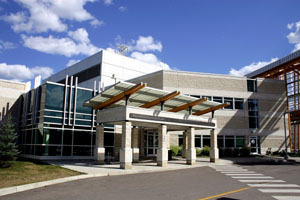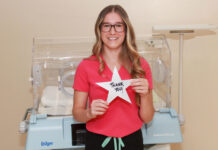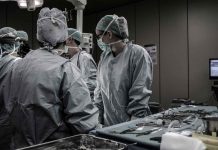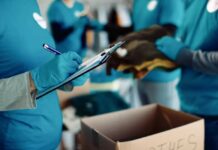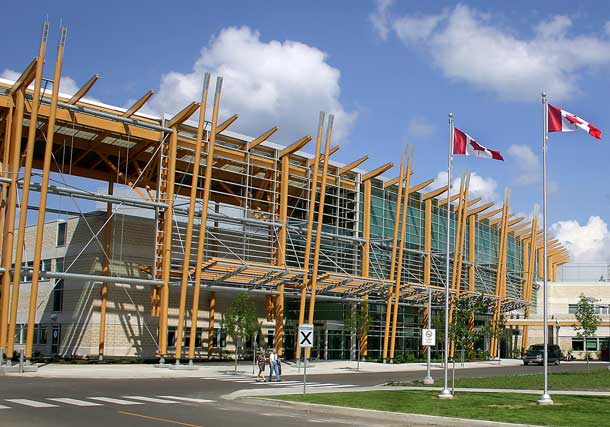
THUNDER BAY – HEALTH – The Operating Room at the Thunder Bay Regional Health Sciences Centre is an area most people have never seen, but is one of the busiest areas in the building. With over 15,000 cases done annually, there is a critical need for up-to-date equipment to ensure each patient receives high-quality care.
Today, it was announced that $109,806 was granted through the Thunder Bay Regional Health Sciences Foundation, thanks to the generosity of donors, to provide enhancements to equipment within the Operating Room.
Chief of Surgery at the Thunder Bay Regional Health Sciences Centre and Board Director, Thunder Bay Regional Health Sciences Foundation, Dr. Mark Thibert made the announcement, stating, “Our Operating Room is one of the most advanced in the province and patients can feel very confident in the quality of care they receive here. This funding provides the opportunity to enhance the care we currently provide and ensures we are well-positioned to meet future surgical needs.”
Items funded were:
- 5 new anesthesia care machines ($96,717)
- 1 skin graft mesher ($5,000)
- 1 TURP (transurethral resection of the prostate) instrument set ($8,089)
“Our Operating Room continues to evolve as techniques become more advanced and patients require increasingly complex procedures,” said Adam Vinet, Director, Surgical and Ambulatory Care Services, Thunder Bay Regional Health Sciences Centre. “Thanks to donors, we are able to select and purchase equipment that provides support for the multitude of cases we perform here in Thunder Bay – whether it be neurosurgery, dental surgery or orthopaedic surgery. We offer a full complement of services, with the exception of cardiac surgery, which is in development. Our community should be very proud of the care that’s provided here, and I’m thankful to those who have made the decision to make a gift to support the excellent care we offer.”
Added Christine Erickson, Manager, Perioperative Services, Thunder Bay Regional Health Sciences Centre, “The equipment we have here ensures that our surgeons, anesthetists, nurses and learners are able to deliver exceptional care. They use evidence-based practice, while working collaboratively, to make sure our patients receive the care that’s most appropriate for them.”
Long-time donors Maurice and Jackie Black were thrilled to be a part of today’s announcement, knowing their most recent gift to the General Healthcare Fund of the Thunder Bay Regional Health Sciences Foundation would make a tangible difference in the Operating Room. “We’ve been happy to support the hospital in a variety of ways, many times to the Cancer Centre,” said Maurice, “but we made the decision to give to the area of highest need this time.” Added Jackie, “We know that whenever we do make a gift, it will always be used for equipment purchases that advance healthcare here in Thunder Bay. We’re exceptionally fortunate to be in good health and not needing the services of the Operating Room, but are glad to know that the patients who need this vital care will be receiving it thanks to this latest equipment and the team of professionals who are so adept at using it.”
About the Equipment Funded
Anesthesia Care Machines (5) $96,717
As explained by Dr. Ian Dobson, Chief of Anesthesia,
Thunder Bay Regional Health Sciences Centre
For the past ten years, we have been using an older generation of anesthesia machines, which are functional but did not allow us to evolve as a service to deal with the increasingly complex and challenging surgeries that we now perform as a regional academic centre. Newer technologies now exist which have been adopted at all teaching hospitals in Ontario and are becoming the standard of care.
These new machines help us to meet the challenges of new programs such as vascular and bariatric surgery and will eventually help us when we have a full cardiovascular surgery program. With the rapid evolution of laparoscopic and minimally-invasive surgeries, our ability to handle the demanding respiratory issues in positioning these patients isn’t possible with the older machines, but is now possible with our new generation of machines. We really see this when we have patients who have long thoracic or gastrointestinal cancer surgeries.
Because of the new machines, we are able to care for patients here instead of having to send them to a larger academic centre, meaning world-class care is available, closer to home.
Skin Graft Mesher (1) $5,000
As explained by Dr. Mark Thibert
Chief of Surgery, Thunder Bay Regional Health Sciences Centre
When we do skin grafts, we are treating extensive wounds, trauma, burns or areas of extensive skin loss due to infection like necrotizing fasciitis or removal of skin cancers. The skin graft mesher creates small perforations in the skin graft so it can be expanded to cover a recipient site that’s larger than the donor site.
It is extremely helpful because it provides improved draining, increases the edge exposure and helps provide more successful outcomes for our patients. These are very delicate surgeries and any equipment that helps us facilitate this process is of utmost importance to our patients.
TURP Instrument Set (1) $8,089
As explained by Ryan Kelly
Registered Nurse & O.R. Team Leader for ENT, Neurology, Ophthalmology, Urology
One of the most common procedures that we perform in the O.R. are transurethral resection of the prostate procedures, or more commonly known as a TURP. TURPs are performed to relieve moderate to severe urinary symptoms often caused by a benign enlarged prostate, and annually we perform almost 300 TURPs alone.
This versatile piece of equipment, known as a resectoscope, doesn’t begin and end with TURPs, however. We also use this same equipment to treat or prevent complications due to blocked urine flow from a variety of conditions, as well as removal of bladder tumours. Having this set of instruments added to our complement decreases the chance for a delay to patient care, as well as relieves the added stress on the staff, knowing that they will have enough sets of instruments to be able to provide for their patients.

